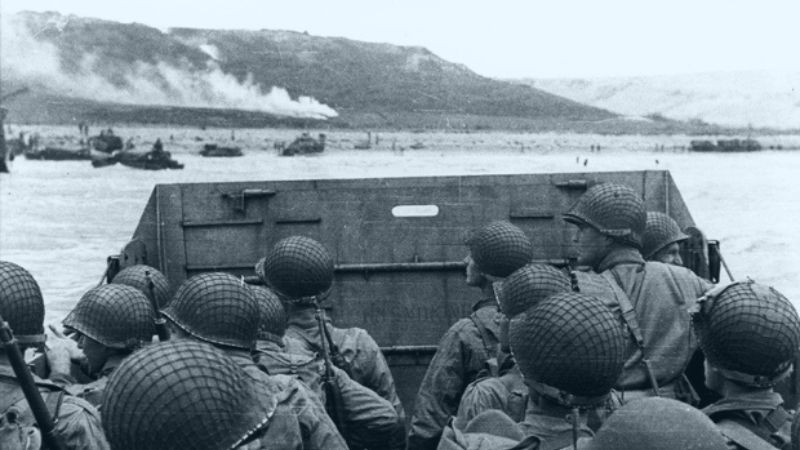
What is D-Day
During World War II, Operation Neptune, the codename of the naval phase of the Allied Invasion of Normandy landing, is often called D-Day. D-Day was the most massive seaborne invasion in history.
It marked the start of the liberation of France (and eventually Western Europe) and created the framework for the Allied victory on the Western Front.
D-Day All Quick Overview
- Time / Date: 6 June
- Category: Historical
- Where It’s Marked: USA
- Why It’s Marked: D-Day is celebrated to honor the American troops and other Allied forces who fought to liberate Europe and defeat Germany in World War II.
History of D-Day
In 1942, the Allies began planning an invasion of German-occupied France. To deceive the Germans and keep the details of the D-Day operation secret, the Allies carried out “Operation Bodyguard,” a military deception. It was part of the false radio communications, false operatives, and a 'phantom army' led by American General George Patton.
Due to weather and tide estimates based on the moon phase, 5 June was first selected as D-Day. However, due to the bad weather, D-Day took place on 6 June.
In the early hours of 6 June, 24,000 airborne troops were parachute-dropped into the battle to seal exits and capture bridges, stopping the advancement of Nazi reinforcements.
At 6:30 in the morning, the amphibious invasions started. Along with the Americans at Utah Beach, the British and Canadians overcame minimal resistance to seizing the beaches known as Gold, Juno, and Sword. At Omaha Beach, US soldiers encountered fierce resistance, resulting in almost 2,000 American casualties.
Troops entering the beaches from the sea and land saw Hitler's "Atlantic Wall," 2,400 miles of bunkers, landmines, and beach barriers built in preparation for a French coast invasion. Along the beaches at Normandy, the Nazis buried 4 million landmines.
However, by the end of the day, some 156,000 Allied soldiers had successfully overtaken the beaches of Normandy. According to some estimates, the D-Day operation cost the lives of almost 4,000 Allied soldiers while leaving thousands more injured or missing.
How to Celebrate D-Day
.jpg)
2023 marks the 79th anniversary of D-Day. To celebrate this day in a true sense, you can-
1. Thank a veteran
As with our military's active-duty veterans, those who served in World War II made significant sacrifices. Understanding the entire extent of their service and sacrifice is challenging for those who have not sacrificed in the same way for our country. But, today, if you are lucky enough to know any veterans personally, don't forget to show your gratitude.
2. Visit The National D-Day Memorial
If you reside near Bedford, Virginia, go to the National D-Day Memorial on 6 June to commemorate the anniversary. The 11 a.m. to 9 p.m. event is free. D-Day is the ideal opportunity to visit this memorial if you have never done so.
3. Visit the museum in New Orleans
The World War II Museum in New Orleans, Louisiana, which opened in 2000, delivers briefings all day long that describe what happened in 1944. Climb aboard one of the vessels that transported our soldiers to the Normandy beaches.
4. Attend The D-Day Commemoration At The WWII Memorial
On 6 June, go to the WWII Memorial in Washington, DC, for a unique memorial celebration. The 16 million Americans who fought in military service throughout the war are honored at the WWII Memorial. During WWII, more than 400,000 people died while defending our nation. The program will start at 11 a.m.
5. Fly The American Flag
This anniversary presents the ideal chance to fly your flag. Reviewing proper flag-flying etiquette never hurts whether you fly the flag daily or occasionally. Keep in mind that a flag should always be flown from a fixed pole, be adequately lit if flown at night, and should be taken down in cases of inclement weather.
6. Watch a WWII movie
You can find over 50 movies that depict aspects of World War II, including battles, heroes, and Holocaust victims. To comprehend the entire extent of this battle and what our triumph has meant to the globe, you can watch those movies and read about the war and the events at Normandy from a number of perspectives.
Countries That Observe D-Day
The US commemorates D-Day in remembrance of the Normandy landings in France on 6 June 1944, when American troops and other Allied forces fought to end World War II.
To honor the soldiers of the allied forces who battled to deliver freedom, French and foreign visitors, including veterans in their 90s, visit Normandy.
Numerous cities, towns, and villages in France and Holland commemorate their liberation on 6 June. The allied forces' success during the Normandy invasion and special honors are offered to the American men who made up most of the allied forces.
Interesting Facts About D-Day
.jpg)
Many people don't know many exciting incidents and facts about D-Day. So, let's learn some of those interesting facts today.
- All invasion-related information was labelled “Bigot,” which is even more top secret than “Top Secret.”
- D-Day was initially scheduled for 5 June, but Due to inclement weather, D-Day was postponed by 24 hours.
- Approximately 17 million maps were created during the planning and execution of D-Day.
- On D-Day, Allied planes dropped 7.2 million pounds of bombs.
- Midget submarines carrying Royal Engineers were sent to conduct covert evaluations of the beaches, including gathering sand samples.
- “Operation Overlord” was the codename for the invasion of Nazi-occupied Europe.
- Field Marshal Gerd von Rundstedt commanded the German army in the west, with 850,000 soldiers at his disposal.
- The Atlantic Wall, a network of coastal defences constructed by Nazi Germany between 1942 and 1944 and extending from Norway to the Franco-Spanish border, was the target of the D-Day operation.
- Over 5 million mines had been planted throughout northern France by the time the Allies invaded on 6 June.
- Only 10% of the 260,000 employees who contributed to the construction of the Atlantic Wall were German.
- Almost 1 million US soldiers arrived in the UK between 1942 and 1944 in preparation for D-Day.
- By D-Day, the Americans had shipped over 7 million tonnes of supplies to the UK.
- Only 100,000 of the 350,000 Resistance members assisting the Allies in their D-Day preparations in France had operational weapons. Around 350,000 Resistance members were helping the Allies to prepare for D-Day from inside France, but only 100,000 of these had working weapons.
- The Allies had 15,766 aircraft at their disposal on the eve of D-Day, and by June 1944, the Luftwaffe’s aircraft numbers had fallen by more than 30:1 in the western theater of the war.
- The USS Arkansas was the oldest Allied battleship in action on D-Day. She received her commission in 1912.
D-Day Quotes
Here are three famous quotes for D-Day.
"I have full confidence in your courage, devotion to duty, and skill in battle. We will accept nothing less than full victory! Good luck! And let us all beseech the blessing of Almighty God upon this great and noble undertaking". — Gen. Dwight D. Eisenhower, Supreme Allied Commander, 6 June 1944
At this historic moment, surely not one of us is too busy, too young, or too old to play a part in a nationwide, perchance, the worldwide vigil of prayer as the great crusade sets forth. — King George VI, radio address, 6 June 1944
I am firmly convinced that our supporting naval fire got us in; that without the gunfire, we positively could not have crossed the beaches. — Col. Stanhope B. Mason, chief of staff, First Infantry Division
FAQ
1. What's the D in D-Day stand for?
Simply put, the D in D-Day stands for day. This code is used for any significant invasion or military operation. Military strategists (and subsequently historians) used plus and minus marks to denote the number of days before and after D-Day. For example, D-5 stood for five days before a D-Day and D+4 for four days after a D-Day.
2. How many have died on D-Day?
At least 10,000 Allied casualties were recorded, with 4,414 confirmed deaths. And the estimates of German casualties on D-Day range from 4,000 to 9,000 troops.
3. What was the Outcome of D-Day?
By the end of August 1944, the Allies had crossed the Seine River, liberated Paris, and driven out the Germans from northwestern France, effectively ending the Battle of Normandy with success.
4. What was the goal of D-Day?
The goal was to take control of Nazi-occupied France so that they might advance into central Europe and destabilize Adolf Hitler's authority.
D-Day Observances
| Year | Weekday | Date | Name | Holiday Type |
|---|---|---|---|---|
| 2023 | Tue | 06 Jun | D-Day | Non Public |
| 2024 | Thu | 06 Jun | D-Day | Non Public |
| 2025 | Fri | 06 Jun | D-Day | Non Public |
| 2026 | Sat | 06 Jun | D-Day | Non Public |
| 2027 | Sun | 06 Jun | D-Day | Non Public |
We constantly update the dates of holidays that keep changing every year. However, while we revise and change some dates to be accurate, if you find any errors, kindly inform us . That will mean a lot to us.



